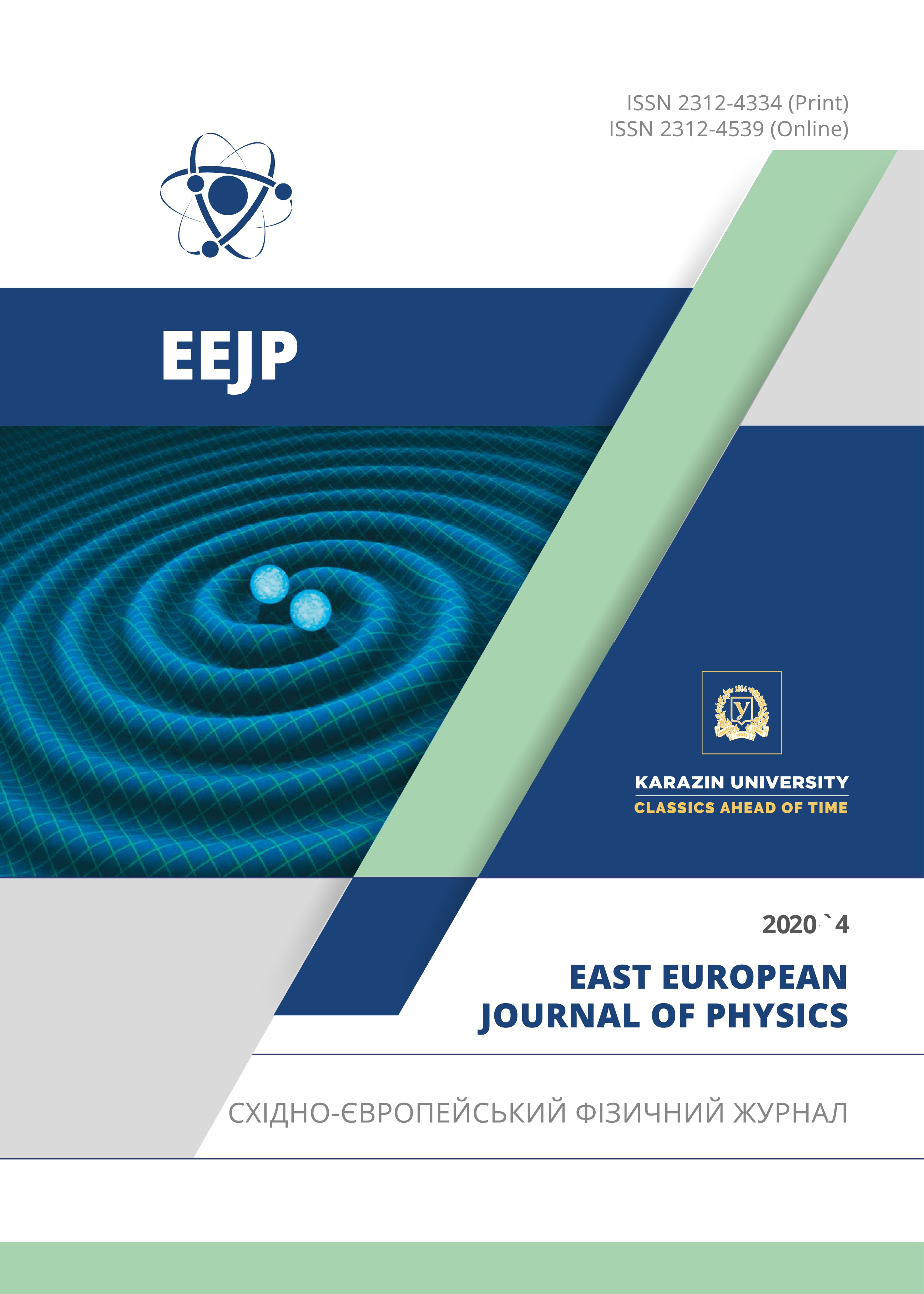Розчинність вуглецю, марганцю та кремнію у α-залізі сплавів системи Fe-Mn-Si-C
Анотація
Дослідження проводили на сплавах з вмістом вуглецю 0,37-0,57 % (мас.), кремнію 0,23-0,29 % (мас.), марганцю 0,7-0,86 % (мас.), решта – залізо. Для визначення фазового складу сплавів використовували мікроструктурний, мікрорентгеноспектральний та рентгеноструктурний аналізи. В роботі були визначені фізичні характеристики сплавів, що досліджували в даній роботі, а саме, залежність відносного видовження, відносного звуження, ударної в’язкості та твердості від хімічного складу сплаву. Отримані в даній роботі результати показали, що найкращі мікроструктурні та фізичні характеристики має сплав на основі заліза з вмістом вуглецю 0,57 % (мас.), кремнію 0,28 % (мас.), марганцю 0,88 % (мас.). Визначено, що після кристалізації та низки фазових перетворень фазовий склад сплаву представлений двома фазами: a‑залізом та легованим марганцем цементитом Fe2.7Mn0,3C. Крім цього, в мікроструктурі сплаву існують ділянки фериту збагачені марганцем та кремнієм. Вперше з застосуванням квазіхімічного методу отримали залежність вільної енергії твердого розчину α-заліза, легованого кремнієм та марганцем, та визначили межу розчинності вуглецю, марганцю та кремнію. В δ-залізі може розчинятись до 0,09 % (мас.) вуглецю, марганцю до 3,5 % (мас.), кремнію – 0,25 % (мас.). Максимальний вміст в α-залізі може досягати: вуглецю – 0,017 % (мас.), марганцю – 21 % (мас.), кремнію – 1,3 % (мас.).
Завантаження
Посилання
Z. Zongy, and S. Rolf, Journal of Alloys and Compounds. 363, 202 (2004), https://doi.org/10.1016/S0925-8388(03)00462-6.
P. Presoly, G. Xia, P. Reisinger, and C. Bernhard, Berg Huettenmaenn Monatsh, 159, 430 (2014), https://doi.org/10.1007/s00501-014-0306-5
J. Miettinen, V.-V. Visuri, and T. Fabritius, Thermodynamic description of the Fe–Al–Mn–Si–C system for modelling solidification of steels, Acta Universitatis Ouluensis C Technica, 704, (University of Oulu, Finland, 2019). pp. 242, http://jultika.oulu.fi/files/isbn9789526222516.pdf.
D. Djurovic, B. Hallstedt, J. Appen, and R. Dronskowski, Calphad, 35(4), 479 (2011). https://doi.org/10.1016/j.calphad.2011.08.002.
W.S. Zheng, X.G. Lu, Y.L. He, and L. Li, J. Iron Steel Res. Int. 24, 190 (2017), https://doi.org/10.1016/S1006-706X(17)30027 4
P. Głowacz, M. Tenerowicz-Żaba, M. Sułowski, and J. Konstanty, International Journal “NDT Days”, II(3), 300 (2019), https://www.bg-s-ndt.org/journal/vol2/JNDTD-v2-n3-a08.pdf.
O.A. Bannykh, and M.E. Drytsa, Диаграммы состояния двойных и многокомпонентных систем на основе железа [Phase Diagrams of Binary and multicomponent Systems based on of the iron: Handbook] (Metallurgiya, Moscow, 1986), pр. 439. (in Russian)
N.P. Lyakishev, Диаграммы состояния двойных металлических систем: Справочник [Phase Diagrams of Binary Metal Systems: Handbook], (Mashinostroenie, Moscow, 2001), pp. 498. (in Russian)
E.G. Hoel, in: Infacon VII, (Trondheim, Norway, 1995), pp. 601, https://www.pyrometallurgy.co.za/InfaconVII/601-Hoel.pdf.
I. Ohnuma, Sh. Abe, Sh. Shimenouchi, T. Omori, R. Kainuma, and K. Ishida, ISIJ International, 52(4), 540 (2012). https://doi.org/10.2355/isijinternational.52.540.
P. Presoly, J. Six, and C. Bernhard, Materials Science and Engineering, 119, 012013-1 (2016). https://doi.org/10.1088/1757-899X/119/1/012013.
S.V. Tverdokhlebova,Vіsnyk Dnіpropetrovskogo nacіonalnogo unіversytetu, serіja Fіzyka, Radіoelektronіka, 14(12/1), 100 104 (2007), http://www.vdnu.narod.ru/v14/pdf/s26_14.pdf. (in Ukrainian)
M.P. Shaskolskaya, Кристаллография [Crystallography], (Vyisshayashkola, Moscow, 1984), pp. 376. (in Russian)
E. Vincent, C.S. Becquart, and C. Domain, Journal of Nuclear Materials, 351, 88 (2006). https://doi.org/10.1016/j.jnucmat.2006.02.018.
N.Yu. Filonenko, O.S. Baskevych, V.V. Soboliev, Naukovyi Visnyk Natsionalnoho Hirnychoho Universytetu, 4, 74 (2012), http://nv.nmu.org.ua/index.php/ru/component/jdownloads/finish/34-04/528-2012-4-filonenko/0. (in Ukrainian)
S.Y.P. Allain, S. Gaudez, G. Geandier, J.C. Hell, M. Gouné, F. Danoix, M. Soler, S. Aoued, and A. Poulon-Quintin, Mater. Sci. Eng. A, 710, 245 (2018), https://doi.org/10.1016/j.msea.2017.10.105.
Y.P. Sébastien, S. Aoued, A. Quintin-Poulon, M. Gouné, F. Danoix, J. Hell, M. Bouzat, and M. Soler, Materials, 11(7), 1087 (2018), https://doi.org/10.3390/ma11071087.
Автори, які публікуються у цьому журналі, погоджуються з наступними умовами:
- Автори залишають за собою право на авторство своєї роботи та передають журналу право першої публікації цієї роботи на умовах ліцензії Creative Commons Attribution License, котра дозволяє іншим особам вільно розповсюджувати опубліковану роботу з обов'язковим посиланням на авторів оригінальної роботи та першу публікацію роботи у цьому журналі.
- Автори мають право укладати самостійні додаткові угоди щодо неексклюзивного розповсюдження роботи у тому вигляді, в якому вона була опублікована цим журналом (наприклад, розміщувати роботу в електронному сховищі установи або публікувати у складі монографії), за умови збереження посилання на першу публікацію роботи у цьому журналі.
- Політика журналу дозволяє і заохочує розміщення авторами в мережі Інтернет (наприклад, у сховищах установ або на особистих веб-сайтах) рукопису роботи, як до подання цього рукопису до редакції, так і під час його редакційного опрацювання, оскільки це сприяє виникненню продуктивної наукової дискусії та позитивно позначається на оперативності та динаміці цитування опублікованої роботи (див. The Effect of Open Access).








